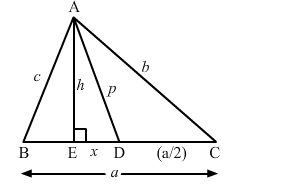In the given figure, D is the midpoint of side BC and AE ⊥ BC. If BC = a, AC = b, AB = c, ED = x, AD = p and AE = h, prove that

(i) $b^{2}=p^{2}+a x+\frac{a^{2}}{4}$
(ii) $c^{2}=p^{2}-a x+\frac{a^{2}}{4}$
(iii) $\left(b^{2}+c^{2}\right)=2 p^{2}+\frac{1}{2} a^{2}$
(iv) $\left(b^{2}-c^{2}\right)=2 a x$
(i)
In right-angled triangle AEC, applying Pythagoras theorem, we have:
$A C^{2}=A E^{2}+E C^{2}$
$\Rightarrow b^{2}=h^{2}+\left(x+\frac{a}{2}\right)^{2}=h^{2}+x^{2}+\frac{a^{2}}{4}+a x \ldots(i)$
In right - angled triangle AED, we have:
$A D^{2}=A E^{2}+E D^{2}$
$\Rightarrow p^{2}=h^{2}+x^{2} \quad \ldots(i i)$
Therefore,
from $(\mathrm{i})$ and $(\mathrm{ii})$
$b^{2}=p^{2}+a x+\frac{a^{2}}{4}$
(ii)
In right-angled triangle AEB, applying Pythagoras theorem, we have:
$A B^{2}=A E^{2}+E B^{2}$
$\Rightarrow c^{2}=h^{2}+\left(\frac{a}{2}-x\right)^{2} \quad\left(\because B D=\frac{a}{2}\right.$ and $\left.B E=B D-x\right)$
$\Rightarrow c^{2}=h^{2}+x^{2}-a x+\frac{a^{2}}{4} \quad\left(\because h^{2}+x^{2}=p^{2}\right)$
$\Rightarrow c^{2}=p^{2}-a x+\frac{a^{2}}{4}$
(iii)
Adding (i) and (ii), we get:
$\Rightarrow b^{2}+c^{2}=p^{2}+a x+\frac{a^{2}}{4}+p^{2}-a x+\frac{a^{2}}{4}$
$=2 p^{2}+a x-a x+\frac{a^{2}+a^{2}}{4}$
$=2 p^{2}+\frac{a^{2}}{2}$
(iv)
Subtracting (ii) from (i), we get:
$b^{2}-c^{2}=p^{2}+a x+\frac{a^{2}}{4}-\left(p^{2}-a x+\frac{a^{2}}{4}\right)$
$=p^{2}-p^{2}+a x+a x+\frac{a^{2}}{4}-\frac{a^{2}}{4}$
$=2 a x$
Click here to get exam-ready with eSaral
For making your preparation journey smoother of JEE, NEET and Class 8 to 10, grab our app now.
